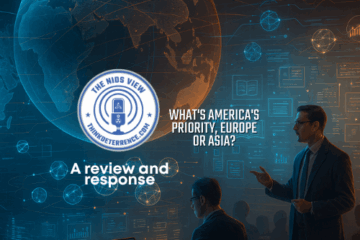The European dream of peace and security for all of Europe is within reach with a new proposed European security architecture. It is an architecture that corrects an ongoing and prevailing North Atlantic Treaty Organization (NATO) malady. While NATO was originally based on a model of shared responsibility, it has morphed into an alliance where 21 out of 32 member-states fail to spend the agreed upon 2 percent of gross domestic product (GDP) on national security. With a war between Ukraine and Russia ongoing, this is detrimental to the alliance and the rest of non-NATO Europe, particularly Ukraine.
NATO is now in its third decade of the post–Cold War era—a period during which all member-states ought to have fulfilled their GDP defense obligation. However, this was never done by the vast majority of NATO members. Most countries maneuvered to avoid this obligation.
European countries comprise 30 of the 32 NATO members, together with the US and Canada. Of the 30 European members, only 10 fulfilled their 2023 2 percent of GDP goal. This leaves a sobering 20 European NATO countries that do not expend the minimum on defense. The “honorable 10 European NATO countries” that do pay their dues are: Poland (3.9 percent), Greece (3.01 percent), Estonia (2.73 percent), Lithuania (2.54 Percent), Finland (2.45 percent), Romania (2.44 percent), Hungary (2.43 percent), Latvia (2.27 percent), the United Kingdom (2.07 percent), and the Slovak Republic (2.03 percent). Outside Europe, the US spent 3.49 percent of its GDP on defense in 2023, while Canada spent 1.38 percent. Overall, it is the 10 honorable European countries and the US that carry Europe’s defense burden.
A decade ago, the Obama administration made it clear to NATO countries in their failure to meet funding obligations, “Everyone has to step up.” The Trump administration called for “burden sharing.” Yet no improvement was made.
The states failing to meet their obligation failed to grasp that today’s global security threat is not just limited to Europe. Their assumption that the US will always be available in an emergency to protect them is no longer viable.
The United States is overextended militarily and economically due to its worldwide security obligations. By necessity, America’s security focus has shifted away from Europe to two other strategic regions: the Indo-Pacific and the Middle East. These increased global threats necessarily draw upon US defense resources—away from Europe. European countries failed to recognize this long ago. It is now time for Europe to have a reality check and to initiate new corrective actions to remedy the ongoing malaise—and the sooner the better.
Non-compliant NATO member-states justifiably deserve a nudge out of their self-imposed “NATO welfare cocoon.” While Russia is rated as the world’s third or fourth military power, it would pale in comparison to a fully funded European NATO superpower. Economically, it would become a European titan versus a Russian pauper. Demographically, it is NATO Europe’s billion inhabitants versus Russia’s 144 million inhabitants. The European component of NATO alone would have deterrence supremacy that casts a protective veil over European countries. As such, Russia would cease to be a bona fide threat to Europe.
To correct the present European security deficiency, the alliance end the manipulation by under-spending NATO member-states. NATO’s Secretary General has long failed to encourage, cajole, or coerce member-states into meeting their obligations. As such it is important that a new Secretary General be appointed from one of the obligation-meeting countries, who can more effectively influence those states that do not contribute adequately. Among those countries who meet their defense spending obligations, there are qualified statesmen ready to lead NATO. A fully funded NATO that can far more effectively deter Russian aggression is the objective.
A new-era Secretary General, to reshape NATO and redirect it toward Europe’s real-world milieu, could redefine the alliance’s perception of the threat it faces and reshape its principles. These principles may well include: (1) accepting that Europe is primarily Europe’s responsibility; (2) realizing America’s global defense commitments extend beyond Europe; (3) acknowledging that America’s army is no longer Europe’s defensive army; (4) insisting that all NATO member-states must meet their minimum 2 percent defense expenditure; and (5) Acknowledging that Europe can no longer fear Russian aggression.
Peace for all of Europe is better assured through a stronger NATO. This must start with a change in leadership. Credible deterrence begins with the financial commitment of NATO’s member-states. Recent moves by Finland and Sweden to join the alliance demonstrate the real strategic threat Russia poses. It is a threat all alliance members must work collaboratively to deter. Russian threats to use nuclear weapons against NATO are only possible because there is a lack of commitment and capability across the alliance.
The underlying issue addressed here is that a fully funded NATO can become the dominant military power in Europe. The resulting nexus of such military supremacy is an interconnected Europe composed of NATO countries and those aligned with the alliance. Such a force is one that despite Russian President, Vladimir Putin’s bluster, he knows that war is a lose-lose proposition. Creating that perception in the mind of Russia’s president is the continued purpose of NATO.
Warren K. Christolon is an international geo-economics and security expert in London, UK Views expressed in this article are the author’s own.




